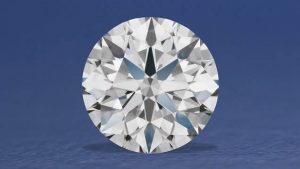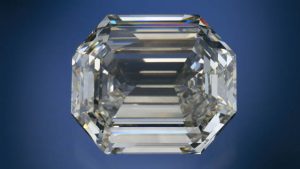CUT
A beautifully finished diamond is dazzling, with every facet displaying the craftsman’s skill and care. When a diamond interacts with light, every angle and every facet affects the amount of light returned to the eye. This is what gives it its face-up appearance.
In efforts to differentiate themselves, and because of increasing demand for precision in cutting, many manufacturers fashioned diamonds to exacting standards throughout the decade. Note the precise arrow pattern in this 1.54 ct diamond.
A diamond’s proportions determine how light performs when it enters the diamond. If light enters through the crown and goes out through the pavilion, the diamond will look dark and unattractive. Diamonds with different proportions and good polish make better use of the light, and will be bright, colorful, and scintillating.
A well-cut diamond displays the beauty consumers expect to see in a diamond.
A beautiful diamond looks the way it does because of three optical effects: white light reflections called brightness, flashes of color called fire, and areas of light and dark called scintillation. Pattern is the relative size, arrangement, and contrast of bright and dark areas that result from a diamond’s internal and external reflections. There must be enough contrast between the bright and dark areas to give the pattern a crisp, sharp look.
The diamond industry has long known that some proportion combinations make light perform better than others. In recent years, however, scientists and researchers in GIA’s Research Department and the GIA Laboratory have shown that there are many variations and combinations of proportions that will maximize brilliance and fire in round brilliant cut diamonds.
As a general rule, the higher the cut grade, the brighter the diamond. Under fluorescent lighting, these diamonds (left to right) display high, moderate, and low brightness.
The term “cut” also can describe a fashioned diamond’s shape. Shapes other than the standard round brilliant are called fancy cuts. They’re sometimes called fancy shapes or fancies. Fancy shapes also have names of their own, based on their shapes. The best known are the marquise, princess, pear, oval, heart, and emerald cut.
Fancy-shape diamonds, along with the classic round diamonds, are popular choices for today’s jewelry consumer. Courtesy Lazare Kaplan Diamonds
CARAT WEIGHT
Many goods are sold by weight—by the kilogram, ounce, pound, or ton. Even people who have never bought a diamond are used to the idea that weight and price are related. They understand that a larger diamond is probably more valuable than a smaller one. But there are two things that often surprise people when they start learning about diamonds and carat weight.
The first is the precision with which diamonds are weighed. Diamond weights are stated in metric carats, abbreviated “ct.” One metric carat is two-tenths (0.2) of a gram—just over seven thousandths (0.007) of an ounce. One ounce contains almost 142 carats. A small paper clip weighs about a carat.
The metric carat is divided into 100 points. A point is one hundredth of a carat.
Diamonds are weighed to a thousandth (0.001) of a carat and then rounded to the nearest hundredth, or point. Fractions of a carat can mean price differences of hundreds—even thousands—of dollars, depending on diamond quality.
Over a carat, diamond weights are usually expressed in carats and decimals. A 1.03-carat stone, for example, would be described as “one point oh three carats,” or “one oh three.” Weights for diamonds that weigh under a carat are usually stated in points. A diamond that weighs 0.83 carat is said to weigh “eighty-three points,” or called an “eighty-three pointer.”
Large high quality diamonds are rare and valuable gems. This diamond weighs a remarkable 100.20 carats and is internally flawless. – © GIA and Harold & Erica Van Pelt, courtesy The Steinmetz Group
The relationship between rarity, weight, and value can be surprising. People know that a pound of sugar costs twice as much as a half-pound of sugar. But diamonds aren’t a commodity like sugar. Their price depends on a number of variables—weight is just one of them. So it’s not always easy to understand, or explain, why a 1-carat diamond is worth, say, $6,000, while a 2-carat diamond of similar quality might be worth $15,000.
It’s really a simple concept: Large diamonds are more rare than small diamonds. The more scarce something is, the more it is worth. So a larger stone doesn’t just cost more. It also costs more per carat. A 1-carat diamond weighs the same as four 0.25-carat diamonds. But even if all the other quality factors are equal, the larger diamond is worth much more than the sum of the four smaller diamonds.
Carat weight can also be symbolic. While the visual difference between a 0.98-carat diamond and a 1.01-carat diamond is negligible, many people will opt for the larger stone—even at a much higher price. Some weights are considered “magic sizes”: half carat, three-quarter carat, one carat, etc. There’s not much difference in their weights, but if both are D-color round brilliants with identical clarity and cut, the size makes all the difference. They really don’t look much different, but if a consumer’s heart is set on the one-carat size, the difference is enormous. The fact that the second stone is slightly over the “magic” one-carat size can give it as much as a 20 percent difference in price with only a 6-point difference in weight.
This oval shape diamond weighs 1.01 carats and made the 1.00 carat magic size range. When diamonds reach the so called magic sizes the value per carat increases. – Courtesy Lazare Kaplan Diamonds
Don’t confuse the term carat with karat. Karat is a unit of measure used to describe how much pure gold there is in an alloy.






